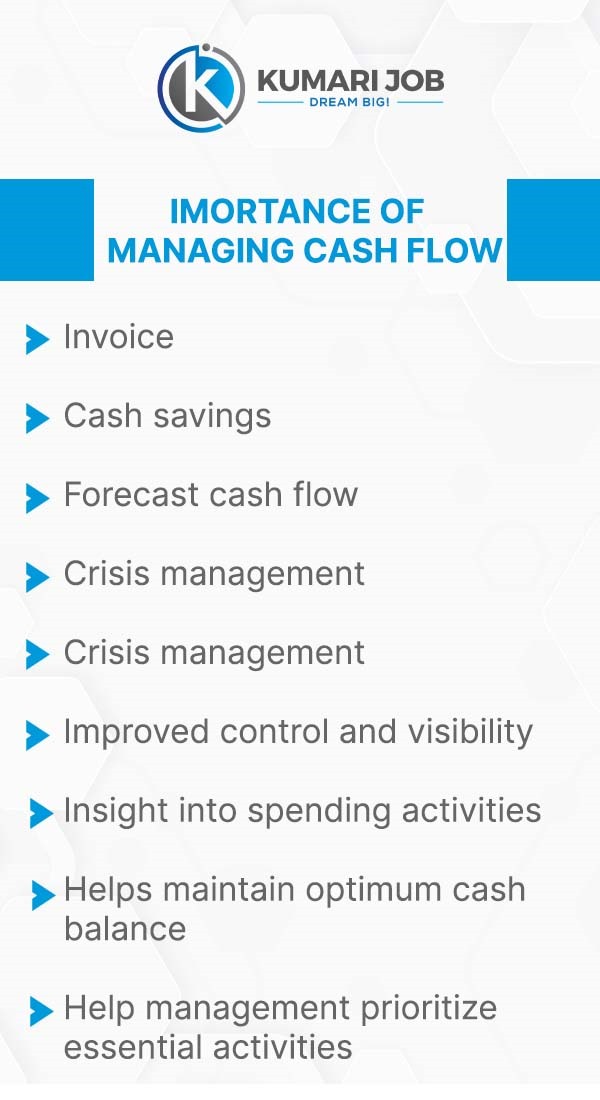
Definition of cash management
Cash management refers to managing the cash and cash equivalents within a business to ensure liquidity, efficiency, and profitability. It involves monitoring, analyzing, and optimizing the company's cash flows, including incoming and outgoing funds, to maintain financial stability and support business operations.
The importance of cash flow optimization for business growth
Cash flow optimization is crucial for businesses, as it directly impacts their ability to grow and thrive. By effectively managing cash flows, businesses can:
1. Ensure operational stability: By maintaining adequate cash reserves, businesses can meet their day-to-day operational expenses, such as payroll, utilities, and inventory purchases, without disruption.
2. Seize growth opportunities: Optimized cash flow enables businesses to invest in expansion initiatives, such as acquiring new assets, entering new markets, or launching new products/services, which are essential for long-term growth.
3. Reduce financial risks: By monitoring cash flows closely, businesses can identify potential cash shortages or liquidity issues in advance, allowing them to take proactive measures to mitigate risks and avoid financial crises.
4. Enhance investor confidence: Consistent and positive cash flow signals financial health and stability to investors, lenders, and other stakeholders, increasing their confidence in the business and its growth prospects.
In summary, cash flow optimization is not only essential for sustaining day-to-day operations but also for fueling business expansion and achieving long-term success. Therefore, implementing effective cash management strategies is paramount for businesses aiming to achieve growth and profitability in today's competitive market.
In this blog
Understanding Cash Flow
A. Explanation of cash flow components (inflows and outflows):
Cash flow consists of two primary components: inflows and outflows.
1. Inflows: Inflows represent the money coming into the business. These typically include:
- Revenue from sales of products or services
- Payments from customers or clients
- Interest earned on investments
- Loans or capital injections from investors
- Other sources of income
2. Outflows: Outflows refer to the money going out of the business. Common outflows include
- Payments to suppliers for goods or services
- Salaries and wages for employees
- Operating expenses such as rent, utilities, and insurance
- Loan repayments
- Taxes
- Investments in assets or equipment
Understanding these components helps businesses track how cash moves within the organization. By analyzing both inflows and outflows, businesses can gain insights into their financial health, liquidity, and potential areas for improvement.
B. Importance of monitoring cash flow:
1. Ensuring liquidity: By tracking cash inflows and outflows, businesses can ensure they have enough cash on hand to cover immediate expenses and obligations, aiding in maintaining a robust accounting system.
2. Identifying trends and patterns: Regular cash flow monitoring allows businesses to identify trends in revenue and expenses, enabling informed decisions regarding budgeting, pricing strategies, and resource allocation, thereby enhancing the accounting process.
3. Planning for the future: Understanding cash flow patterns helps businesses forecast future cash needs and plan accordingly, including setting aside funds for expansion, investment opportunities, or unforeseen expenses, contributing to a comprehensive accounting strategy.
4. Managing debt and financing: Monitoring cash flow helps businesses assess their ability to meet debt obligations and determine their capacity for additional financing. It also allows businesses to negotiate favorable terms with lenders based on their cash flow performance, facilitating effective accounting practices.
In summary, monitoring cash flow provides businesses with valuable insights into their financial performance, enabling them to make informed decisions, manage risks, optimize their overall financial health, and help maintain a better accounting system in the business.
Know more about accounting: https://www.kumarijob.com/blog/career-tips/accounting
Common Cash Management Challenges
Seasonal fluctuations:
Seasonal fluctuations refer to the variations in a business's cash flow that occur due to changes in demand, sales, or expenses during different times of the year. These fluctuations can pose challenges to cash management for several reasons.
- Increased expenses: Businesses may experience higher expenses during peak seasons, such as increased production costs, marketing expenses, or hiring temporary staff to meet demand.
- Uneven cash flow: Seasonal businesses often encounter periods of high revenue followed by slower periods with lower income. Managing cash flow during these fluctuations requires careful planning to ensure sufficient funds are available to cover expenses during lean periods.
- Inventory management: Seasonal fluctuations can impact inventory levels, leading to excess inventory during slow seasons and shortages during peak demand. Managing inventory effectively is crucial to avoid tying up cash in excess stock or losing sales opportunities due to stockouts.
Delayed payments:
Delayed payments occur when customers or clients take longer than expected to settle their invoices or accounts receivable. This can create cash flow challenges for businesses, as it affects the timing of cash inflows. Common reasons for delayed payments include:
- Slow payment processes: Some customers may have lengthy approval processes or payment cycles, delaying settling invoices
- Cash flow constraints: Customers facing cash flow challenges may delay payments to preserve their liquidity.
- Disputes or discrepancies: Inaccuracies in invoices or disputes over goods or services can lead to payment delays.
- Excess inventory ties up cash: Having too much inventory on hand means that a significant portion of cash is invested in unsold goods, reducing liquidity and financial flexibility.
- Obsolete inventory: Outdated or unsellable inventory represents wasted resources and capital, posing a financial burden and reducing profitability.
- Stockouts lead to lost sales: Insufficient inventory levels result in missed sales opportunities, as customers may turn to competitors when desired products are unavailable, impacting revenue and market share.
Managing delayed payments requires businesses to implement efficient invoicing and collections processes, establish clear payment terms, and communicate effectively with customers to resolve any issues promptly.
Inventory management: Inventory management refers to the process of overseeing and controlling the flow of goods or materials within a business. Effective inventory management is essential for cash flow optimization because:
- Holding excessive inventory ties up valuable cash that could be used for other business purposes. Businesses need to strike a balance between maintaining adequate stock levels to meet customer demand and minimizing excess inventory.
- Poor inventory management can result in the accumulation of obsolete or slow-moving inventory, which not only ties up cash but also incurs storage costs and reduces profitability.
- Inadequate inventory levels can result in stockouts, leading to lost sales opportunities and potential damage to customer relationships.
- Implementing inventory management best practices, such as regular inventory audits, demand forecasting, and adopting just-in-time inventory principles, can help businesses optimize their inventory levels and improve cash flow management.
Shortening cash conversion cycle:
1. Negotiating better payment terms with suppliers:
By negotiating better payment terms with suppliers, businesses can extend the time they have to pay for goods or services they receive. This effectively lengthens the period between the receipt of inventory or materials and the outflow of cash, thereby improving the company's cash conversion cycle.
For example, businesses can negotiate for extended payment periods, such as net 30 or net 60 terms, allowing them to hold onto cash for a longer period before settling invoices. Alternatively, businesses may negotiate early payment discounts with suppliers, incentivizing prompt payment while still benefiting from improved cash flow.
2. Accelerating receivables collection:
- Implementing strategies to shorten the time for customers to pay outstanding invoices or accounts receivable accelerates receivables collection.
- Accelerating payments helps reduce the cash conversion cycle and enhances cash flow for businesses.
- Additionally, offering alternative payment methods like online payments or electronic funds transfers facilitates quicker remittance.
- These strategies collectively aim to enhance liquidity, reduce reliance on external financing, and improve overall financial health by shortening the cash conversion cycle.
5. Techniques for accelerating receivables collection include:
- Offering discounts for early payments.
- Implementing stricter credit policies to minimize overdue accounts.
- Utilizing automated invoicing and payment reminders to prompt prompt settlement.
Efficient Inventory Management
Efficient inventory management is crucial for businesses to optimize cash flow and operational efficiency. Here's an explanation of two key strategies:
1. Implementing just-in-time inventory:
Just-in-time (JIT) inventory management is a strategy aimed at minimizing inventory levels by ordering and receiving goods only when they are needed for production or sale. This approach helps businesses reduce carrying costs associated with excess inventory, such as storage, insurance, and obsolescence, while also freeing up cash that would otherwise be tied up in inventory.
How it works: Instead of maintaining large stockpiles of inventory, businesses order goods from suppliers as needed to fulfill customer orders or replenish depleted stock. This allows businesses to operate with minimal inventory levels, reducing the risk of overstocking and associated costs.
Benefits:
Improved cash flow: By minimizing inventory levels, businesses can reduce the amount of capital tied up in inventory, freeing up cash for other operational needs or investment opportunities.
Lower carrying costs: With less inventory on hand, businesses can reduce storage costs, minimize the risk of obsolescence, and lower the need for warehouse space.
Increased responsiveness: JIT inventory management enables businesses to adapt quickly to changes in customer demand, market trends, or supply chain disruptions, improving agility and competitiveness.
2. Utilizing inventory management software:
Inventory management software systems provide businesses with tools and capabilities to streamline inventory tracking, control, and optimization processes. These software solutions offer features such as real-time inventory tracking, demand forecasting, order management, and reporting, enabling businesses to manage their inventory more effectively and efficiently.
How it works: Inventory management software automates various tasks related to inventory management, such as tracking stock levels, managing purchase orders, and generating reports on inventory performance. Businesses can set up alerts and notifications to monitor inventory levels and reorder points, ensuring optimal stock levels are maintained.
Benefits:
Enhanced accuracy: Inventory management software helps eliminate manual errors and discrepancies by providing real-time visibility into inventory levels and transactions.
Improved efficiency: Automation of inventory-related tasks saves time and resources, allowing businesses to focus on core activities and strategic initiatives.
Better decision-making: Inventory management software provides valuable insights and analytics on inventory performance, demand trends, and supplier relationships, enabling informed decision-making and proactive inventory optimization.
By implementing just-in-time inventory practices and utilizing inventory management software, businesses can improve inventory control, reduce costs, and optimize cash flow, ultimately enhancing overall operational efficiency and competitiveness.
Establishing cash reserves
1. Creating an emergency fund: This entails setting aside a portion of funds to cover unexpected expenses or financial emergencies. By having an emergency fund, individuals or organizations can mitigate the impact of unforeseen circumstances such as medical emergencies, job loss, or major repairs without having to resort to borrowing or liquidating assets at unfavorable terms.
2. Investing excess cash wisely: Once an emergency fund is established, any additional surplus cash can be allocated towards investments that offer potential returns while maintaining liquidity and minimizing risk. This may include short-term investments such as money market funds, treasury bills, or certificates of deposit, providing an opportunity for earning interest on idle cash without sacrificing accessibility.
Leveraging technology for cash forecasting involves
1. Using cash flow forecasting tools: Cash flow forecasting tools use historical data and predictive analytics to accurately predict future cash inflows and outflows, aiding businesses in making informed decisions about budgeting, investment strategies, and working capital management.
2. Implementing automated payment systems: Automated payment systems improve cash flow management by automating repetitive tasks, ensuring timely payments, and reducing errors or late fees by integrating with accounting software and financial management systems.
Case Studies of Effective Cash Flow Management
1. Manufacturing Company: A manufacturing company was experiencing a significant delay in receiving payments from its customers, resulting in a prolonged cash conversion cycle. This affected their ability to meet operational expenses and invest in growth opportunities. By leveraging asset-based lending, they were able to secure a revolving line of credit based on their accounts receivable and inventory. This allowed them to access immediate funds to cover their working capital needs while waiting for customer payments. As a result, they were able to reduce their cash conversion cycle by 30%, improving their overall financial health and enabling them to take advantage of new business opportunities.
2. Retail Business: A retail business faced seasonal fluctuations in sales, leading to inconsistent cash flow throughout the year. This made it challenging for them to manage inventory levels and meet supplier payment obligations. Through asset-based lending, they obtained a line of credit secured by their inventory and accounts receivable. This provided them with the flexibility to increase inventory during peak seasons and bridge any gaps in cash flow during slower periods. As a result, they were able to optimize their inventory management, reduce stockouts, and improve customer satisfaction while maintaining healthy cash flow levels.
Conclusion
Effective cash management is crucial for businesses to maintain financial stability, support operational needs, and drive growth. Strategies like establishing cash reserves, utilizing technology for forecasting, and efficient inventory management can mitigate risks, seize growth opportunities, and improve performance. Case studies show tangible benefits, such as reduced cash conversion cycles, improved inventory control, and flexible financing options. Prioritizing cash flow optimization helps businesses navigate challenges, adapt to market dynamics, and achieve sustainable success.
Frequently Asked Questions
- Cashflow forecasting
- Cut expenses
- Digitize your payments
- Inventory management
- Minimizing cash balance
- Enforce late payment terms
- Improved profitability
- Liquidity management
- Working capital management
For example, cash handling daily to ensure accurate deposits, managing smart safes, ordering cash and coins so change is available for customers, and having access to easy accounting tools to manage these operations is invaluable to proper cash management optimization.
Step 1: Forecast inflows and outflows of funds and prepare a budget accordingly.
Step 2: Incorporate different cash management strategies like offering discounts to the debtors.
Step 3: Negotiate with the suppliers to enter into the best payment terms with them.
- Stewardship. The careful and responsible management of something entrusted to one's care
- Accountability. One person has sole responsibility for a fund
- Separation of Duties
- Physical Security
- Reconciliation
- Operating cash flow.
- Investing cash flow.
- Financing cash flow.
Operating Cash Flow = Operating Income + Depreciation – Taxes + Change in Working Capital.









Loading Comments...